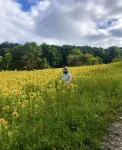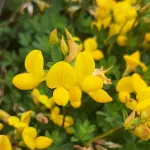(Press-News.org) AMHERST, Mass. – It’s the spines. This is the conclusion of two new papers, led by researchers at the University of Massachusetts Amherst, showing that the spiny pollen from plants in the sunflower family (Asteraceae) both reduces infection of a common bee parasite by 81 – 94% and markedly increases the production of queen bumble bees. The research, appearing in Functional Ecology and Proceedings of the Royal Society B: Biological Sciences, provides much-needed food for thought in one of the most vexing problems facing biologists and ecologists: how to reverse the great die-off of the world’s pollinators.
Insect pollinators—those flying, buzzing flitting bugs that help fertilize everything from blueberries to coffee—contribute upwards of $200 billion in annual ecosystem services, worldwide. “We depend on them for diverse, healthy, nutritious diets,” says Laura Figueroa, incoming assistant professor of environmental conservation at UMass Amherst and the lead author of the paper on pollen spines. However, many pollinators are suffering an unprecedented decline, due to the widespread use of pesticides, habitat loss and other causes, and scientists around the world are working diligently to figure out how to fight the apocalypse.
One of the big breakthroughs in helping pollinators, and especially bees, is the discovery that certain species of flowers can help pollinators resist disease infections, and that sunflowers are particularly effective at combatting a widespread pathogen that lives in a bee’s gut, called Crithidia bombi.
But until now, no one knew why sunflowers were so effective at staving off C. bombi, or if other flowers in the sunflower family had the same pathogen-fighting powers.
Physics, not chemistry
“We know that the health benefits from some foods come from the specific chemicals in them” says Figueroa. “But we also know that some foods are healthy because of their physical structure—think of foods high in fiber.”
To discover how sunflowers help bumblebees withstand C. bombi, Figueroa and her team devised an experiment that hinged on separating out the pollen’s spiny outer shell from the chemical metabolites in the pollen’s core. They then mixed the spiny sunflower shell, with the chemistry removed, into the pollen fed to one batch of bees, while another batch was fed wildflower pollen sprinkled with sunflower metabolites and no sunflower shells.
“We discovered that the bees that ate the spiny sunflower pollen shells had the same response as bees feeding on whole sunflower pollen, and that they suffered 87% lower infections from C. bombi than bees feeding on the sunflower metabolites,” says Figueroa.
But that’s not all. Bees fed pollen from ragweed, cocklebur, dandelion and dog fennel—all members of the sunflower family and with similarly spiny pollen shells—had low rates of C. bombi infection similar to the bees who ate sunflower pollen—which raises the possibility that such disease-fighting medicinal effects may be common to plants in the sunflower family.
Food fit for a queen
One of the counter-intuitive aspects of the new research is that sunflower pollen is not in itself all that nutritious, because sunflower pollen is low in protein. And while the pollen might be great at protecting bumblebees from a gut pathogen like C. bombi, it would be of little use to feed bumblebees sunflowers and relatives if malnutrition resulted.
“It’s no good curing the common cold if you starve the patient,” says Lynn Adler, professor of biology at UMass Amherst and the senior author of the paper looking at sunflower pollen and queen bee production. “We need to look at the community level, as well as what’s happening in bees’ guts, to know how to help them respond to stressful environments,” says Adler.
One way to gauge a colony’s health is by the number of queens it produces, because queens are the way a bumble bee colony passes on its genes to the next generation. And queens aren’t born, they’re grown. Colonies use the food resources they’ve collected to turn a small number of bee larvae into daughter queens. Once the cold weather arrives, all the workers and the old queen will die. The only bees that survive are the new daughter queens. If they survive the winter, they will produce an entirely new colony in the spring. The more queens a colony produces, the higher the likelihood that a colony’s genes be passed down through many generations of bees.
To test the impact of sunflowers on colony health, Adler and her team placed commercial colonies of bumblebees on twenty different farms in Western Massachusetts, which grew varying amounts of sunflowers. Over the course of several weeks, the team sampled the pathogens collecting in their bees’ guts, weighed the colonies to determine whether or not they were thriving and counted the number of daughter queens.
“What we found is that infection decreased with increasing sunflower abundance, and perhaps more importantly, queen bee production increased by 30% for every order of magnitude increase in the availability of sunflower pollen,” says Rosemary Malfi, lead author of the paper and who completed the research as part of her postdoctoral work in Adler’s lab.
Though there’s more research to be done into exactly why sunflower pollen benefits queen bees—perhaps bumblebees have more energy for reproduction if they’re not fighting disease, or maybe C. bombi impairs learning and foraging, so that reducing infection increases the bees’ ability to find food—Adler says that “it’s really exciting to show that sunflower not only reduces disease, but positively affects reproduction.”
Next Steps
Figueroa and Adler are quick to point out that this research, which was supported by the US National Science Foundation and Department of Agriculture, does not represent a solution to the insect apocalypse. This research was conducted using just one common species of bumblebees, which is not endangered. More research needs to be done into how Asteraceae pollen affects other bumblebee species that are threatened. Nor is it known exactly how the spiny Asteraceae pollen protects against C. bombi. But these initial results are encouraging, and indicate that the sunflower family may very well play a role in maintaining pollinator health, and, ultimately, the health of our own food systems.
Contacts: Laura Figueroa, llf44@umass.edu
Daegan Miller, drmiller@umass.edu
END
UMass Amherst research finds surprising science behind bumblebee superfood
Sunflower family’s spiny pollen vastly reduces prevalence of widespread parasite in bumblebees, increases production of queens
2023-04-05
ELSE PRESS RELEASES FROM THIS DATE:
Hundreds of very shallow earthquakes detected in California’s Long Beach and Seal Beach
2023-04-05
Seismic arrays deployed in California’s Long Beach and Seal Beach areas detected more than a thousand tiny earthquakes over eight months, many of them located at surprisingly shallow depths of less than two kilometers below the surface.
The findings, reported in Seismological Research Letters, confirm that the region’s portion of the Newport-Inglewood fault splays widely at these shallow depths, showing for the first time with seismic evidence that it may spread out by more than a kilometer.
The destructive 1933 magnitude 6.4 Long Beach earthquake may have ruptured in part on the Newport-Inglewood fault. ...
People misremember events within just seconds, often re-shaping their memories to fit their expectations
2023-04-05
People misremember events within just seconds, often re-shaping their memories to fit their expectations
###
Article URL: https://journals.plos.org/plosone/article?id=10.1371/journal.pone.0283257
Article Title: Seeing Ɔ, remembering C: Illusions in short-term memory
Author Countries: The Netherlands, Canada
Funding: AKS is grateful to the European Research Council (ERC-2020-ADG, grant 1010192654) for support. END ...
Hypergentrification of NYC neighborhoods is associated with better mental health for White populations, but not among Black and Latino populations
2023-04-05
Hypergentrification of NYC neighborhoods is associated with better mental health for White populations, but not among Black and Latino populations
###
Article URL: https://journals.plos.org/plosone/article?id=10.1371/journal.pone.0283191
Article Title: Can changing neighborhoods influence mental health? An ecological analysis of gentrification and neighborhood-level serious psychological distress—New York City, 2002–2015
Author Countries: USA
Funding: The authors received no specific funding for this work. END ...
Researchers tend to co-author with individuals of the same gender, partly because of demography, norms and gender representation, but seemingly also through personal preference
2023-04-05
Researchers tend to co-author with individuals of the same gender, partly because of demography, norms and gender representation, but seemingly also through personal preference
###
Article URL: https://journals.plos.org/plosone/article?id=10.1371/journal.pone.0283106
Article Title: Gender-based homophily in collaborations across a heterogeneous scholarly landscape
Author Countries: USA
Funding: This research was supported by the Royalty Research Fund Grant #A118374 awarded to EE (PI) and CL (co-PI), National Science Foundation Grant #1735194 awarded to JW (co-PI), and National Science Foundation SMA 19-52069 to CTB. https://www.washington.edu/research/or/royalty-research-fund-rrf/; ...
Smartphone plant identification apps may not be accurate enough to be relied on, especially in avoiding toxic plants when foraging
2023-04-05
Smartphone plant identification apps may not be accurate enough to be relied on, especially in avoiding toxic plants when foraging
###
Article URL: https://journals.plos.org/plosone/article?id=10.1371/journal.pone.0283386
Article Title: A repeatable scoring system for assessing Smartphone applications ability to identify herbaceous plants
Author Countries: Ireland, UK
Funding: The authors received no specific funding for this work. END ...
To counteract conspiracy beliefs, most–but not all–existing methods are ineffective
2023-04-05
A new review of previously published studies on methods for reducing conspiracy beliefs has shown that most of these methods are ineffective, but that those focused on fostering critical thinking or an analytical mindset show some promise. Cian O’Mahony of University College Cork, Ireland, and colleagues present these findings in the open-access journal PLOS ONE on April 5.
Evidence from prior studies suggests that belief in conspiracy theories can be associated with harmful consequences, such as—in the case of ...
Euchromatin is not really open in living cells
2023-04-05
DNA and associated proteins in active regions of the genome are condensed but behave like a viscous liquid at the molecular level. This finding greatly increases our understanding of the physical nature of expressed genome regions in living human cells.
The human genome DNA has a remarkable capacity for compaction. When 46 sets of human chromosomes are stretched end to end, they collectively reach two meters in length but are somehow arranged in a nucleus with only about ten micrometers in diameter. To fit inside the nucleus, the strands of DNA are wrapped ...
A new type of photonic time crystal gives light a boost
2023-04-05
Researchers have developed a way to create photonic time crystals and shown that these bizarre, artificial materials amplify the light that shines on them. These findings, described in a paper in Science Advances, could lead to more efficient and robust wireless communications and significantly improved lasers.
Time crystals were first conceived by Nobel laureate Frank Wilczek in 2012. Mundane, familiar crystals have a structural pattern that repeats in space, but in a time crystal, the pattern repeats in time instead. While some physicists were ...
Beneath the Earth, ancient ocean floor likely surrounds the core
2023-04-05
Embargoed: Not for Release Until 2:00 pm U.S. Eastern Time Wednesday, 05 April 2023.
TUSCALOOSA, Ala. — Through global-scale seismic imaging of Earth’s interior, research led by The University of Alabama revealed a layer between the core and the mantle that is likely a dense, yet thin, sunk ocean floor, according to results published today in Science Advances.
Seen only in isolated patches previously, the latest data suggests this layer of ancient ocean floor may cover the core-mantle boundary. Subducted underground long ago as the Earth’s plates shifted, this ultra-low velocity zone, or ULVZ, is denser than the rest ...
Most existing methods to tackle conspiracy beliefs are ineffective, study finds
2023-04-05
A new review of methods for reducing conspiracy beliefs has shown that most methods are ineffective, but that those focused on fostering critical thinking or an analytical mindset show some promise.
Led by researchers at University College Cork (UCC), the study is the first comprehensive review of the effectiveness of various conspiracy interventions. It is published in PLOS ONE.
While holding conspiracy beliefs has been associated with several detrimental social, personal, and health consequences, little research has been dedicated to systematically reviewing the methods that could reduce conspiracy beliefs.
To ...
LAST 30 PRESS RELEASES:
Exposure to natural light improves metabolic health
As we age, immune cells protect the spinal cord
New expert guidance urges caution before surgery for patients with treatment-resistant constipation
Solar hydrogen can now be produced efficiently without the scarce metal platinum
Sleeping in on weekends may help boost teens’ mental health
Study: Teens use cellphones for an hour a day at school
After more than two years of war, Palestinian children are hungry, denied education and “like the living dead”
The untold story of life with Prader-Willi syndrome - according to the siblings who live it
How the parasite that ‘gave up sex’ found more hosts – and why its victory won’t last
When is it time to jump? The boiling frog problem of AI use in physics education
Twitter data reveals partisan divide in understanding why pollen season's getting worse
AI is quick but risky for updating old software
Revolutionizing biosecurity: new multi-omics framework to transform invasive species management
From ancient herb to modern medicine: new review unveils the multi-targeted healing potential of Borago officinalis
Building a global scientific community: Biological Diversity Journal announces dual recruitment of Editorial Board and Youth Editorial Board members
Microbes that break down antibiotics help protect ecosystems under drug pollution
Smart biochar that remembers pollutants offers a new way to clean water and recycle biomass
Rice genes matter more than domestication in shaping plant microbiomes
Ticking time bomb: Some farmers report as many as 70 tick encounters over a 6-month period
Turning garden and crop waste into plastics
Scientists discover ‘platypus galaxies’ in the early universe
Seeing thyroid cancer in a new light: when AI meets label-free imaging in the operating room
Neutrophil-to-lymphocyte ratio may aid risk stratification in depressive disorder
2026 Seismological Society of America Annual Meeting
AI-powered ECG analysis offers promising path for early detection of chronic obstructive pulmonary disease, says Mount Sinai researchers
GIMM uncovers flaws in lab-grown heart cells and paves the way for improved treatments
Cracking the evolutionary code of sleep
Medications could help the aging brain cope with surgery, memory impairment
Back pain linked to worse sleep years later in men over 65, according to study
CDC urges ‘shared decision-making’ on some childhood vaccines; many unclear about what that means
[Press-News.org] UMass Amherst research finds surprising science behind bumblebee superfoodSunflower family’s spiny pollen vastly reduces prevalence of widespread parasite in bumblebees, increases production of queens









